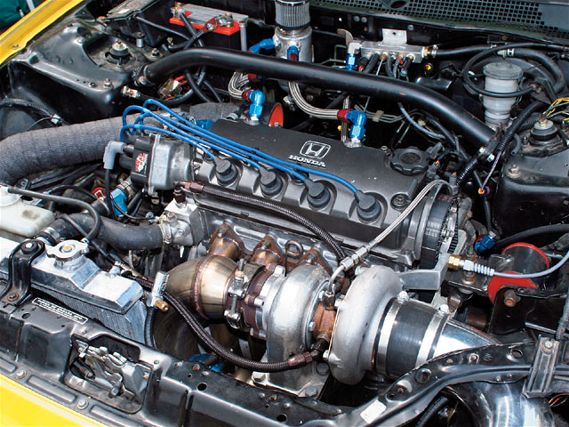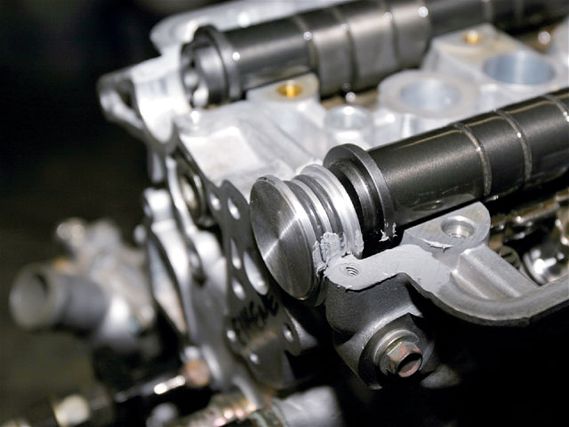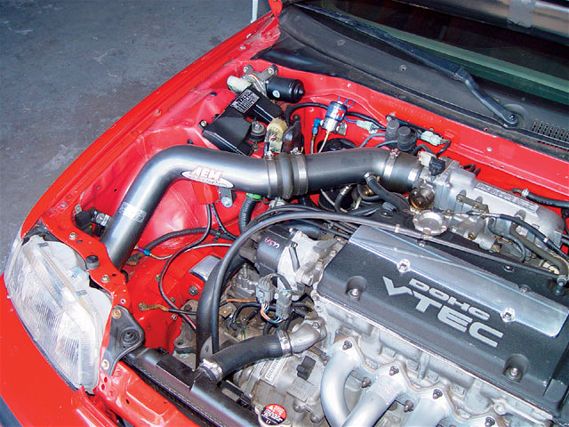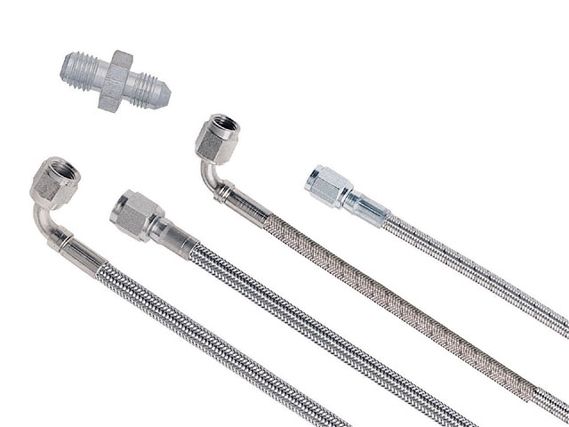High-Compression Woes
 | Honda Engine Swap Questions Answered and More! - April 2008 Exhaust Notes
| Honda Engine Swap Questions Answered and More! - April 2008 Exhaust Notes
I'm getting a D16Z6. It is fitted with 11.5:1 compression pistons, aftermarket rods and it was bored over but I don't know by how much. It also has a block guard welded in and the block was decked. As for the head, it has been ported and polished, fitted with an aftermarket camshaft and an STR cam gear. An all-motor setup is nice but I'm a very big fan of boost. So my question is: Can I boost this engine safely?Mario Bejarano / Casa Grande, Ariz.
Simply put, no. There's just no way you can safely boost an 11.5:1 compression engine and expect to drive it on the street...reliably anyway. You are planning on driving it on the street aren't you? If not, then it's an entirely different story because reliability boils down to octane. As static compression ratios rise-meaning the 11.5:1 number you get from calculating the empty space when the piston's at TDC versus the empty space when it's at BDC-so does the need for higher octane. Adding boost won't add to this figure but you can bet cylinder pressures will rise dramatically furthering the need for higher octane. You're better off swapping those pistons for something in the 10.0:1 range or less, dropping a thicker multilayer head gasket in place or else scrapping the whole turbo idea, sticking to the all-motor setup.
More High-Compression Woes
I was flipping through my enormous stack of HT mags and came across a past issue where, in the Exhaust Notes section, a reader wrote in about his Jackson Racing blown car. You guys told him you preferred higher compression with boost and that lower compression with boost was ideal in the day since the combustion chambers weren't effi cient. I have a D16Y8 Civic with a GReddy turbo kit with an eManage (blue) controlling the tune. I really want to rebuild the engine with SRP 10.5:1 pistons and keep the boost where it is (7-8 psi) rather than use lowcompression pistons and increase the boost, but every person or technician I talk to says it isn't smart and the reason they give has to do with the diffi culty to tune a setup like this. A 10.5:1 ratio is not much higher then the stock ratio but are they correct in saying that it will be diffi cult to tune? And with an eManage at that? (I have the support tool, pressure sensor and ignition and injector harness with my system.) Hopefully this can be answered. The magazine rocks, keep up the good work.Brad Froehlich / Pittsburgh, Pa.
Brad, make sure you read our response to Mario's question first and then come back here. Finished? OK, same thing applies here. Mixing high-static compression ratios and boost is almost never worth it. Is there a potential for more horsepower when comparing two similarly boosted engines, one with a higher compression ratio? Sure there is. Will the higher compression engine exhibit a bit more low-end grunt and a more efficient burn? Pretty much. But adding compression-especially on a boosted engine-makes everything more volatile. A bad batch of gas, a boost spike or an abnormally hot day could be all it takes to put your D16 over the edge; and by over the edge we mean busted ring lands, cracked cylinders, you know the drill. But you wanted to know if high-compression turbo engines are harder to tune. They are...sort of. They are in the sense that your tuner's got to walk a much finer line in terms of air/fuel ratios and timing. Remember that whole volatility thing I just mentioned? Well, discrepancies in ignition timing and fuel delivery that might be acceptable on a low-compression engine become much more serious as dynamic cylinder pressures rise. It's not really "physically" harder for the guy to tune your car but it is a much riskier, more delicate proposition.
That Infamous Leak
 | Honda Engine Swap Questions Answered and More! - April 2008 Exhaust Notes
| Honda Engine Swap Questions Answered and More! - April 2008 Exhaust Notes
Dear Honda Tuning, I have a CR-VTEC in my '93 Civic coupe and I have that small oil leak at the passenger-side front. I have changed the VTEC pressure switch spool valve and distributor O-ring. Can you help me clear this leak up?Josh Rathburn / Pomeroy, Ohio
This probably isn't news to you but the leak you're referring to is just about the most infamous one known to the automotive world. Really though, cam seal leaks and B-series engines sort of go hand in hand, like America and apple pie or cake and ice cream. We can't tell you how many bone-stock B16, B18 and B20 engines we've seen sporting this very bit of residual oil drool you speak of, though. We'd suggest changing your exhaust camshaft's distributor-side cam seal. Honda actually makes two different types: a soft, rubber-like one and a hard plastic one that seals with its own O-ring. There are also a couple of aftermarket alternatives that also use an O-ring. They all work, but they all require a dab of Hondabond or RTV sealant to ensure against that pesky leak returning. Just be careful not to get too crazy with the silicone though because bits and pieces can make their way into the oil stream once hardened, eventually clogging the oil pickup-never a good thing.
Engine Swap Drama
 | Honda Engine Swap Questions Answered and More! - April 2008 Exhaust Notes
| Honda Engine Swap Questions Answered and More! - April 2008 Exhaust Notes
Hey Honda Tuning, I recently became the proud owner of a '91 Civic hatchback DX. I was wondering if you could answer a couple of questions for me regarding an engine swap. I'm thinking about doing an H22A swap. What modifications will I have to do? How hard is the swap? What else do I need to change besides my axles to make everything work fine? What are the ups and downs of doing this engine swap? I appreciate any kind of feedback. Keep up the great work with future issues!Rogelio Perez via the Internet
Stuffing an H-series into your EF chassis is definitely a bit more work then going the B-series route but, thanks to companies like Hasport, the swap's fairly straightforward. Plan on a doing a few modifications, however, that you wouldn't otherwise have to do when swapping in a different engine family. You'll need to remove the spot-welded, right-side framerail bracket for starters and stitch weld the Hasport bracket into place. Yes, you'll need to weld here, which, for obvious reasons, doesn't make this a bolt-on proposition. You'll also need to do some cutting and grinding underneath the same framerail to make room for the transmission. More nonbolt- on stuff. Next, get out your biggest hammer and massage the firewall to allow clearance for the intake manifold. And then there's more cutting, you'll need to prepare two holes in the firewall to make room for the shifter cables to travel through. Oh, and you'll need to swap out your hood. The H's oil pan sits a little too close to the pavement for comfort so Hasport engineered its mounts to account for this rather then allowing it to become the victim of the next oversized speed bump. As such, you'll need to get yourself an SiR hood or complete SiR front-end conversion. The rest of the swap won't differ a whole lot from doing a B-series. You've got wiring to do either way, axles to swap out, shifter mechanisms to fit in place and throttle cables to figure out. The ups? Pound for pound the H22A's just got more low-end grunt then anything this side of a K-series, plain and simple. The downs? This is no afternoon, bolt-in engine swap.
Clutch Player
 | Honda Engine Swap Questions Answered and More! - April 2008 Exhaust Notes
| Honda Engine Swap Questions Answered and More! - April 2008 Exhaust Notes
I'm doing an H22A swap into an EG coupe. I enjoyed the article you guys did awhile back on this swap. I have a question though. You used a steel braided clutch line to adapt the Civic line to the H22A tranny since the OEM steel line does not clear the cooling fan. My question is: Where did you find this short male-to-male braided line and what brand is it? Thanks so much, the article helped a lot.William Vidmar / Albuquerque, N. Mex.
OK, there are probably a dozen ways to solve the EG H22A clutch line situation, but you're not asking how to do it, you just need some help getting the right parts. You'll actually need five pieces to make this all happen. Start with a section of -4 steel braided hose-the kind with the Teflon liner inside that's suitable for the highe pressures hydraulic systems exhibit-then get yourself a couple of -4 female hose ends. We'll let you figure out any specific angles you might need. And now for the part you were asking about. We're guessing you're planning on leaving the short section of rubber hose that spans between your Civic's original slave cylinder hard line and the hard line that runs along your framerail. The end of the hose that terminates closest to the slave cylinder has a 10x1.0mm female thread pitch-the same as your slave cylinder. All this means is that you need to get yourself two 10x1.0mm x -4 adapters. Just make sure you get the ones with the flared ends on the metric sides to seal up nicely against the corresponding OEM flares on your line and slave cylinder. Oh, but you wanted to know where you can get these. Try Earls, they make everything you want.
TIMEWASTER OF THE MONTH
Delayed Reaction - I was contacting you in regards to Leon Casino's CRX that was in your magazine some time ago. The writer of the story went on and on about the "real" Mugen parts on the car and how "real" Mugen parts are all he will put on his car. Well, there are at least a few fake parts on that car. Name, address and manhood withheld
You do realize you're referencing an article that was published more than two years ago, right? At any rate, we've previously been made aware of the situation but are happy to address it again for you latecomers. Unfortunately, we just don't have the resources to inspect and verify the authenticity of what the owners of the cars we feature claim to be genuine parts. Most of the time, we catch this stuff though. Like the guy who claimed to have a fully built Accord mill with ARP pistons (among other mysterious internals). This was all fine and good except for the fact that ARP doesn't make pistons. Or the guy who claimed to put out 400-plus hp on 87 octane. Naturally aspirated. Do people lie about their setups? Sometimes. Do they get away with it? Hardly ever. Should you be worried about it two years later? Probably not.
Got questions, comments, love or hate?
Send your letters to:
editorial@hondatuningmagazine.com
Or snail mail to:
2400 E. Katella Avenue, Suite 1100
Anaheim, CA 92806
